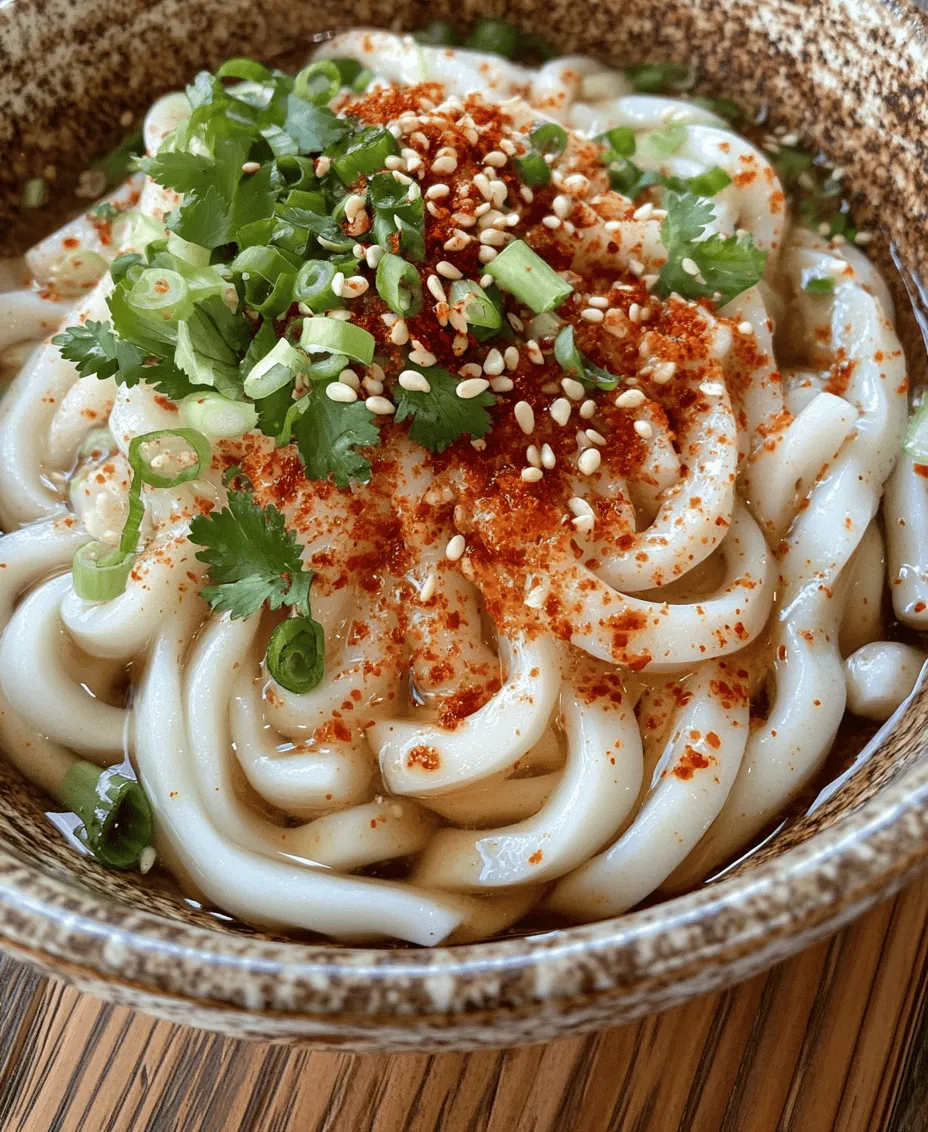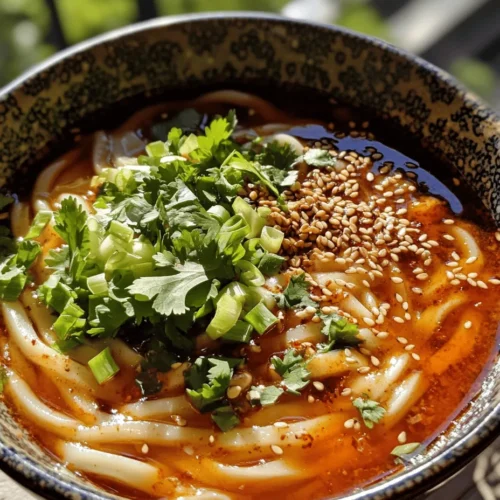Introduction
Udon noodles, with their thick, chewy texture and subtle flavor, have long been a staple in Asian cuisine, particularly in Japanese dishes. These versatile noodles can be served in a variety of ways, from hot soups to cold salads, making them a favorite among food lovers around the world. The appeal of udon lies not just in its satisfying chewiness but also in its ability to absorb flavors from accompanying sauces and ingredients, creating a delightful culinary experience.
One of the standout ingredients that can elevate udon noodles to a new level is chili oil. This fiery oil, infused with a blend of spices and seasonings, is a beloved condiment in many Asian households. It adds depth, heat, and a tantalizing aroma to dishes, transforming even the simplest meals into something extraordinary. For those who enjoy a bit of spice, chili oil is an essential ingredient that enhances the flavor profile of udon noodles, creating a harmonious balance between heat and savory goodness.
This Quick Chili Oil Udon Noodles recipe is designed for busy individuals looking for a delicious and satisfying meal that can be prepared in no time. With a preparation time of just 20 minutes, this dish is not only quick to make but also bursting with flavor, making it perfect for weeknight dinners or a quick lunch. In this article, we will delve into the world of udon noodles, the role of chili oil in Asian cuisine, and provide a breakdown of the ingredients used in this delectable recipe.
Understanding Udon Noodles
Udon noodles are thick wheat noodles that originate from Japan, characterized by their smooth and chewy texture. Unlike other types of noodles, udon is made from just a few simple ingredients: wheat flour, water, and salt. This simplicity allows for a clean flavor that pairs well with a wide range of sauces and toppings.
The texture of udon is one of its most appealing qualities. When cooked properly, these noodles have a delightful chew, providing a satisfying bite that enhances the overall eating experience. Their versatility is another reason for their popularity; they can be served hot in a savory broth, stir-fried with vegetables and proteins, or even chilled with dipping sauces during hot summer months.
Nutritionally, udon noodles are a good source of carbohydrates, providing energy for your daily activities. They are low in fat and can be a part of a balanced diet when paired with vegetables, lean proteins, and healthy fats. Additionally, udon contains some essential vitamins and minerals, particularly when made from whole wheat flour.
When selecting udon noodles, you have the option of choosing between fresh and dried varieties. Fresh udon noodles are typically softer and have a more delicate texture, while dried udon is more shelf-stable and has a firmer bite. When cooking with udon, it’s essential to follow the package instructions to achieve the perfect texture. Generally, fresh udon noodles require a shorter cooking time, while dried noodles may need a few extra minutes to reach that ideal chewiness.
The Role of Chili Oil in Asian Cuisine
Chili oil is a popular condiment in various Asian cuisines, known for its bold flavor and vibrant heat. It is typically made by infusing oil with dried chili peppers, garlic, ginger, and other spices, resulting in a fragrant and spicy oil that can be drizzled over dishes, used as a cooking oil, or served as a dipping sauce.
The significance of chili oil extends beyond its heat; it adds complexity and depth to dishes, enhancing the overall flavor profile. In many Asian cultures, chili oil is not just a condiment but an integral part of the cooking process. It can be used to stir-fry vegetables, marinate meats, or drizzle over soups, making it an incredibly versatile ingredient in any kitchen.
There are two main types of chili oil: store-bought and homemade. Store-bought chili oil can vary significantly in flavor and heat level, with some brands offering a milder, more subtle taste, while others pack a serious punch. Homemade chili oil allows you to customize the flavor and heat level to your preference, making it a fantastic option for those who enjoy cooking. By experimenting with different spices and ingredients, you can create a chili oil that perfectly complements your culinary style.
The addition of chili oil to udon noodles not only provides heat but also enhances the overall flavor, making each bite more exciting. Whether you prefer a mild spice or a fiery kick, chili oil is the perfect way to elevate your udon noodles and turn a simple meal into a flavorful feast.
Ingredients Breakdown
To prepare Quick Chili Oil Udon Noodles, you will need a handful of ingredients that come together to create a delicious dish. Here’s a closer look at each component:
Udon Noodles
As the star of this dish, udon noodles are essential for achieving the desired texture and flavor. You can choose between fresh or dried udon noodles, depending on what’s available and your personal preference. Fresh noodles, often found in the refrigerated section of Asian grocery stores, tend to have a softer texture and cook quickly. Dried noodles, on the other hand, require more time to cook but have a longer shelf life.
Cooking Tips: When preparing udon noodles, be sure to boil them in a large pot of salted water. This will help to enhance their flavor. Follow the package instructions for the best cooking time, and rinse the noodles under cold water after cooking to stop the cooking process and remove any excess starch.
Chili Oil
Chili oil is the key ingredient that brings heat and flavor to the dish. While you can easily find store-bought chili oil, making it from scratch allows for a personalized touch. Homemade chili oil can be tailored to your taste by adjusting the type and amount of chili peppers used.
Making Chili Oil from Scratch: To make your own chili oil, simply heat a neutral oil (like vegetable or canola oil) in a pan, then add crushed red pepper flakes, minced garlic, and other spices such as ginger or Sichuan peppercorns. Allow the mixture to simmer gently, infusing the oil with flavors before straining it into a jar. This process takes just a few minutes but results in a fragrant oil that can be used in various dishes.
Garlic
Garlic is a staple ingredient in many cuisines, known for its aromatic qualities and health benefits. It adds a savory depth to the udon noodles, complementing the heat from the chili oil. Garlic is rich in antioxidants and has anti-inflammatory properties, making it a nutritious addition to your meals.
Preparation Tip: For this recipe, you can mince or thinly slice the garlic, depending on your preference for garlic intensity. Sautéing it briefly in the chili oil will release its flavor and aroma, creating a fragrant base for the dish.
Soy Sauce and Rice Vinegar
Soy sauce is a fundamental ingredient in Asian cooking, providing umami flavor and saltiness to dishes. In this recipe, it acts as a seasoning for the udon noodles, adding depth and richness.
Rice vinegar, on the other hand, offers a mild tanginess that balances the richness of the soy sauce and the heat from the chili oil. Together, these two ingredients create a harmonious flavor profile that enhances the overall dish.
Sesame Oil
Sesame oil is known for its nutty flavor and aroma, making it a perfect addition to udon noodles. It not only contributes to the dish’s taste but also provides nutritional benefits, including healthy fats and antioxidants.
Usage: A little goes a long way with sesame oil, so a small drizzle at the end of cooking will elevate the dish without overpowering the other flavors.
Spring Onions, Sesame Seeds, and Fresh Herbs
To finish off your Quick Chili Oil Udon Noodles, you’ll want to add fresh garnishes such as spring onions, sesame seeds, and herbs like cilantro or basil. These ingredients not only enhance the presentation of the dish but also add complementary flavors and textures.
– Spring Onions: Sliced thinly, they provide a fresh crunch and a mild onion flavor.
– Sesame Seeds: Toasted sesame seeds add a delightful crunch and nutty taste.
– Fresh Herbs: Whether you prefer cilantro or basil, these herbs bring brightness and freshness to the dish.
Optional Ingredients
If you’re looking to customize your Quick Chili Oil Udon Noodles further, consider adding optional ingredients such as chili flakes for an extra kick or vegetables like bell peppers, broccoli, or snap peas for added nutrition and texture.
By understanding the key ingredients and their roles in this dish, you’re well on your way to creating a delicious bowl of Quick Chili Oil Udon Noodles that is sure to impress. In the next part of this article, we will explore the step-by-step instructions for preparing this delightful meal, ensuring you achieve the perfect balance of flavors and textures in your udon noodles.

Step-by-Step Cooking Instructions
Cooking the Udon Noodles
To make the perfect Quick Chili Oil Udon Noodles, start by cooking the udon noodles. The timing is crucial; overcooked noodles can become mushy and unappetizing. Bring a large pot of water to a rolling boil and add the udon noodles. Typically, fresh udon noodles require 2-3 minutes of cooking time, while dried udon may take longer (about 7-10 minutes). Always refer to the package instructions for precise timing.
Once the noodles are cooked to al dente perfection, drain them in a colander and rinse under cold water. Rinsing is essential as it halts the cooking process and removes excess starch, preventing the noodles from sticking together. Set the rinsed noodles aside while you prepare the sauce.
Preparing the Sauce
Next, focus on creating the sauce that will elevate your udon noodles. In a mixing bowl, combine soy sauce, sesame oil, rice vinegar, and the star of the dish—chili oil. The balance of flavors is key; taste as you go. If you prefer a milder sauce, reduce the amount of chili oil or add a bit of sugar to mellow the heat. For those who enjoy a robust flavor, feel free to increase the chili oil or add a pinch of crushed red pepper flakes for an extra kick.
For customization, consider incorporating fresh minced garlic or ginger into the sauce. These ingredients will enhance the aromatic profile and add depth to each bite. Whisk the sauce until well-blended, ensuring an even distribution of flavors.
Combining Noodles and Sauce
Now, it’s time to bring it all together. In a large mixing bowl, add the cooked udon noodles, then pour the prepared sauce over them. Use tongs or chopsticks to gently toss the noodles, ensuring that each strand is evenly coated with the sauce. This technique prevents clumping and guarantees that every bite is bursting with flavor. If the mixture seems too dry, a splash of reserved noodle cooking water can help loosen the sauce and improve overall texture.
Serving Suggestions
For an appealing presentation, plate the noodles in shallow bowls or deep plates. Consider garnishing with sliced green onions, sesame seeds, and a sprinkle of fresh cilantro for a pop of color and added freshness. If desired, a drizzle of extra chili oil on top can provide visual appeal and indicate the dish’s spicy nature.
For a complete meal, serve your udon noodles alongside a side of steamed dumplings or a light cucumber salad to balance the richness of the dish.
Time Management Tips for Quick Meal Preparation
To streamline your cooking process, prep your ingredients before starting. Chop vegetables, measure out sauces, and have all components ready. This mise en place approach not only saves time but also reduces stress while cooking. Additionally, consider using pre-made sauces or store-bought chili oil if you’re in a hurry. Remember, the goal is to create a delicious meal quickly without compromising on flavor.
Flavor Profile and Variations
The flavor profile of Quick Chili Oil Udon Noodles is a delightful medley of spicy, savory, and aromatic notes. The umami from the soy sauce, the nuttiness of sesame oil, and the bold heat from the chili oil create a satisfying taste experience that is both comforting and exciting.
To accommodate different dietary preferences, there are plenty of variations you can explore. For a vegan version, ensure that the chili oil and soy sauce are plant-based (some brands may contain animal products). For a gluten-free option, substitute regular soy sauce with tamari, which offers a similar flavor without gluten.
If you’re looking to create a heartier meal, consider adding protein sources such as cubed tofu, shredded chicken, or sautéed shrimp. Vegetables like broccoli, bell peppers, and snap peas can also be tossed in during the cooking process for added nutrition and texture. This flexibility allows you to personalize the dish according to your taste and dietary needs.
Nutritional Information
A single serving of Quick Chili Oil Udon Noodles contains approximately 400-500 calories, depending on the specific ingredients and portion sizes used. The dish primarily consists of carbohydrates from the udon noodles and healthy fats from the sesame oil and chili oil.
In terms of macronutrients, you can expect around 15-20 grams of protein if you include a protein source, 70-80 grams of carbohydrates, and about 15 grams of fat. Each ingredient offers its own health benefits; for example, udon noodles provide energy, while sesame oil is rich in antioxidants and healthy fats.
When it comes to portion control, a serving size of 1.5 cups of noodles is generally sufficient for an adult. However, feel free to adjust according to your personal dietary needs and activity level.
Pairing Suggestions
To enhance your dining experience, consider pairing your Quick Chili Oil Udon Noodles with side dishes or beverages that complement the flavors. A light, crisp salad with a sesame vinaigrette would provide balance and freshness. Alternatively, a bowl of miso soup can add warmth and depth to your meal.
In terms of beverages, iced green tea or a light lager would work beautifully, cutting through the richness of the noodles while refreshing the palate.
Culturally, udon noodles are often served as part of a larger meal in Asian cuisine, frequently accompanied by tempura, pickled vegetables, or a variety of side dishes that showcase seasonal ingredients. Embracing this cultural context can enhance your dining experience and inspire new meal ideas.
Conclusion
The Quick Chili Oil Udon Noodles are a testament to the joy of cooking—simple, flavorful, and incredibly satisfying. This dish not only exemplifies the balance of heat and umami but also serves as a versatile canvas for your culinary creativity. Whether you stick to the original recipe or venture into various adaptations, the possibilities are endless.
I encourage you to experiment with the ingredients and make this recipe a staple in your quick meal planning. Cooking should be a joyous experience, and sharing flavorful meals with family and friends can foster connections and create lasting memories. Try these Quick Chili Oil Udon Noodles today, and relish in the satisfaction of a delicious homemade dish that comes together in no time.



